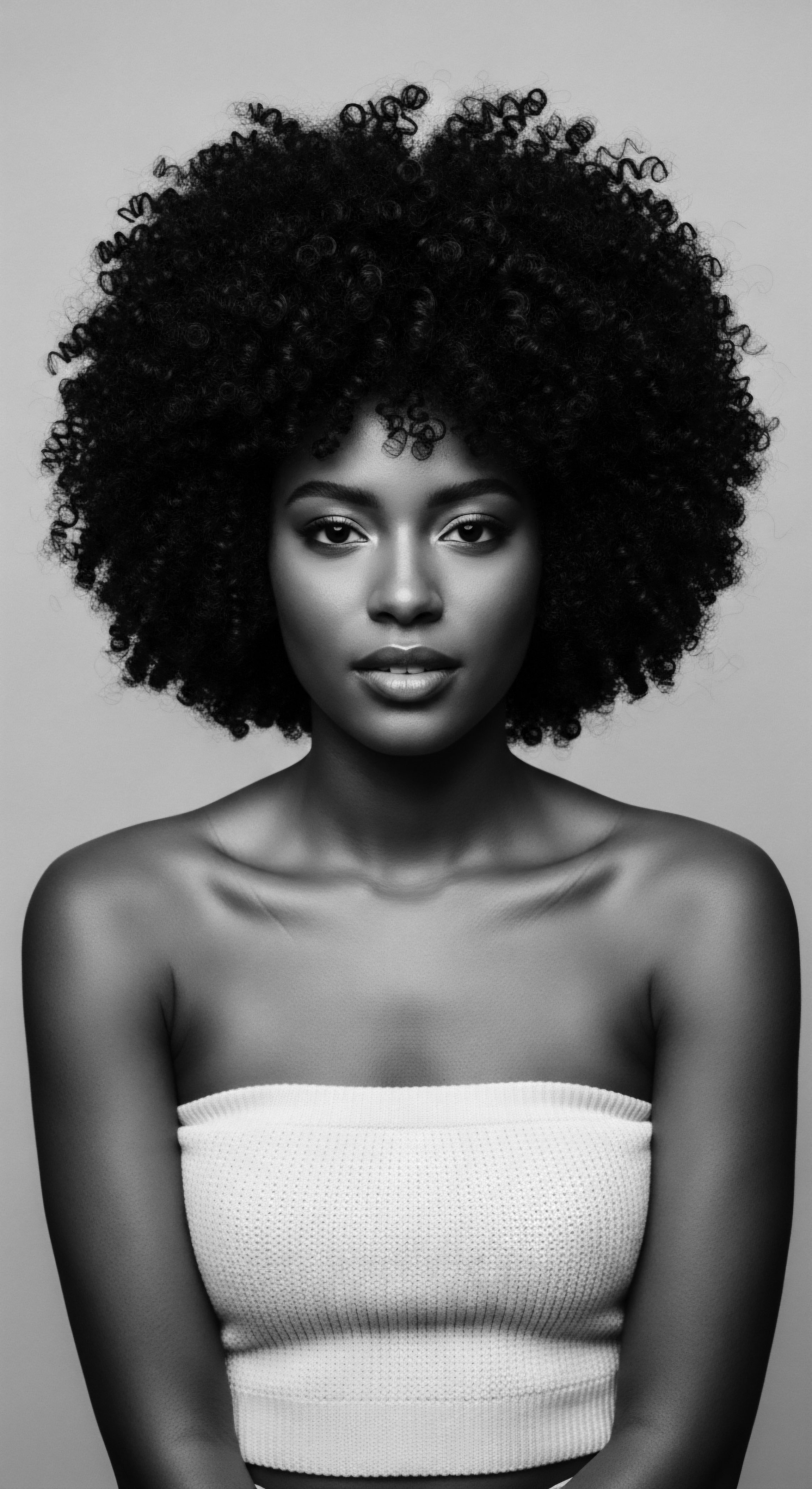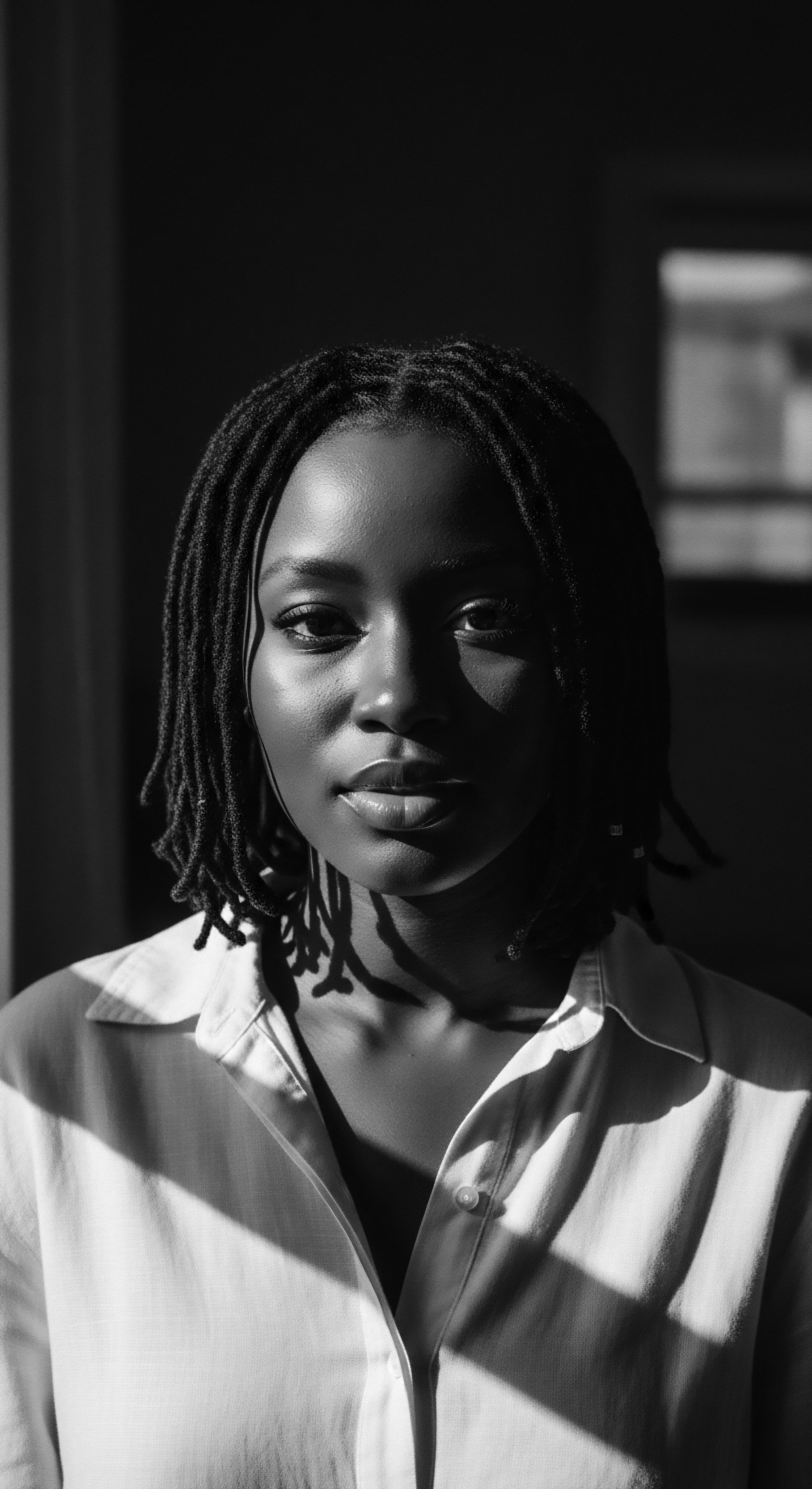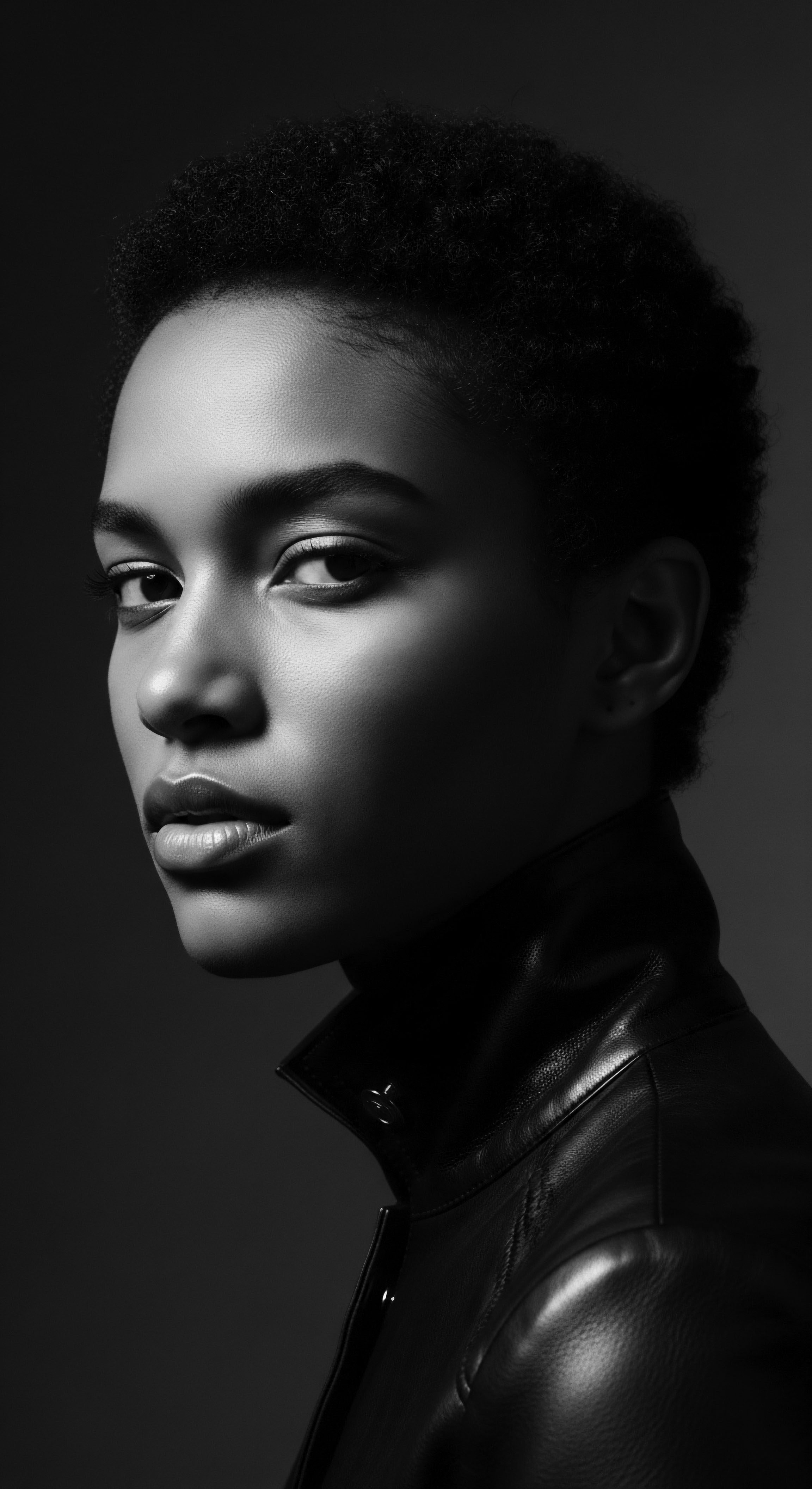
Fundamentals
The very notion of Cation Exchange Capacity, often abbreviated as CEC, carries within its scientific designation a quiet echo of ancient wisdom, particularly for those of us who hold the heritage of textured hair close to our hearts. At its most straightforward, CEC describes a hair strand’s ability to hold onto positively charged ions, or cations, exchanging them with others in its environment. Think of it as a delicate dance of attraction and release happening at the microscopic level of each individual strand.
This interaction is deeply rooted in the hair’s inherent structure, primarily its keratin proteins, which possess a natural negative charge. This negative charge acts as a magnet, drawing in the positively charged elements that surround it, whether from the water we use for cleansing, the botanical infusions passed down through generations, or the modern elixirs we apply.
Understanding this fundamental electrical property is not merely an academic exercise; it forms the bedrock upon which generations of hair care practices, both intuitive and intentional, have been built. The surface of untreated human hair carries a strong negative charge, primarily due to the carboxyl groups found in amino acids like glutamine and aspartic acid, alongside sulfonic acid groups. This intrinsic negativity means hair naturally seeks out positive counterparts. When we consider the diverse textures that grace our communities—the tightly coiled strands, the springy curls, the gentle waves—we recognize that each possesses a unique surface topography, influencing how readily these exchanges occur.
Cation Exchange Capacity is the hair’s inherent ability to attract and bind positively charged ions, a property fundamental to how our strands interact with the world and the products we apply.

The Hair’s Magnetic Pull ❉ A Simple Elucidation
Imagine each strand of hair as a tiny, living magnet, possessing a slight negative charge. This magnetic quality is not arbitrary; it arises from the very building blocks of hair, particularly its protein structure. When water, with its dissolved minerals, or hair care ingredients, which often carry their own charges, come into contact with hair, an interaction unfolds.
Positively charged particles, known as cations, are drawn to the hair’s negatively charged surface. The Cation Exchange Capacity is, in essence, the measure of how many of these positive ions a hair strand can hold onto.
This concept might seem abstract, yet its meaning is woven into the very fabric of our hair experiences. A hair strand with a higher Cation Exchange Capacity can potentially absorb and retain more beneficial, positively charged ingredients, such as those found in traditional conditioning agents or nourishing plant extracts. Conversely, it also means it might hold onto unwanted minerals from hard water with greater tenacity.

A Historical Whisper ❉ Water and Hair
Consider the ancestral practice of washing hair with rainwater. Across various communities, particularly in parts of Africa, rainwater was prized for its softness. This preference was not merely anecdotal; it carried a scientific basis.
Rainwater typically has a lower mineral content compared to well water or river water, meaning fewer positively charged mineral ions to bind to the hair. This allowed traditional cleansing agents, often derived from plants, to work more effectively, without the interference of excessive mineral buildup that could impede the hair’s natural vitality.

Intermediate
Moving beyond the foundational understanding, the Cation Exchange Capacity begins to reveal its deeper implications for textured hair heritage. This isn’t simply about attraction; it’s about the dynamic interplay of charges that dictates how our hair responds to care, how it retains moisture, and how it reflects the health passed down through generations. The hair fiber, composed primarily of keratin, carries a net negative charge at its typical pH. This negative charge is particularly pronounced in textured hair due to its unique structural characteristics, including its often more open cuticle layers, which can expose more anionic (negatively charged) sites.
The CEC of hair, therefore, is a quantification of these available negative sites, reflecting the hair’s capacity to adsorb positively charged substances. These substances, often called cationic compounds, include the beneficial ingredients found in many conditioners, which possess positive charges that readily adhere to the negatively charged hair fiber. This adhesion is crucial for reducing friction between strands, smoothing the cuticle, and ultimately enhancing the hair’s manageability and luster.

The Tender Thread ❉ CEC and Traditional Care Rituals
Ancestral hair care practices, developed over millennia, often intuitively optimized for the principles now understood through Cation Exchange Capacity. Consider the widespread use of clays, like bentonite or rhassoul, in various African and diasporic hair traditions for cleansing and conditioning. These natural clays are rich in minerals and often possess a net negative charge, but when suspended in water, they can interact with the hair in complex ways, potentially binding to impurities or excess oils, while also allowing for the deposition of beneficial trace elements.
Another compelling instance lies in the use of certain plant-based rinses. Many traditional botanical ingredients, when prepared as infusions or decoctions, release compounds that can interact with the hair’s surface charge. For example, some plants contain saponins, natural cleansing agents, or tannins, which can slightly alter the hair’s surface. A study on ethnobotanical practices in Afar, Northeastern Ethiopia, identified 17 plant species used for hair and skin care, with leaves being the most frequently utilized part.
Ziziphus spina-christi, for instance, was noted for its anti-dandruff properties, while Sesamum orientale leaves were used for cleansing and styling. While not explicitly framed in terms of CEC, these practices demonstrate a deep, experiential understanding of how natural substances interact with hair to promote health and manageability.
The Cation Exchange Capacity explains why traditional hair care, with its emphasis on natural ingredients and gentle cleansing, often yields hair that feels soft, strong, and deeply nourished.

The Dance of Ions ❉ How Products Interact
The science behind modern hair care products, especially conditioners, directly leverages the concept of Cation Exchange Capacity. Shampoos typically contain anionic surfactants, which are negatively charged detergents. These cleanse the hair by reducing its natural negative charge and helping to remove dirt and oils. After rinsing, a lower negative charge often remains, indicating some shampoo residue.
Conditioners, conversely, are formulated with cationic compounds—positively charged polypeptides or silicones—that are strongly attracted to the hair’s remaining negative charge. This positive charge helps to neutralize the negative charge, reducing static electricity and friction, making hair smoother and more manageable.
This immediate interaction is why conditioners can be absorbed so quickly, often within seconds. The efficiency of this process highlights the hair’s intrinsic CEC at play. The more available sites for these cationic compounds to bind, the more pronounced the conditioning effect.
| Aspect Cleansing Agents |
| Traditional Practice (Ancestral Wisdom) Plant-based saponins (e.g. Sapindus mukorossi, Yucca root), natural clays (e.g. bentonite, rhassoul), wood ash rinses. These often gently interact with hair's surface. |
| Modern Formulation (Scientific Understanding) Anionic surfactants (e.g. sulfates) to remove oils and dirt. May increase negative charge on hair. |
| Aspect Conditioning Agents |
| Traditional Practice (Ancestral Wisdom) Herbal infusions (e.g. hibiscus, marshmallow root), natural oils (e.g. coconut, olive, castor oil), fermented rice water. Often provide a protective layer or subtle charge interaction. |
| Modern Formulation (Scientific Understanding) Cationic surfactants (quaternary ammonium compounds), silicones, fatty alcohols. Positively charged to adhere to negatively charged hair. |
| Aspect CEC Optimization |
| Traditional Practice (Ancestral Wisdom) Intuitive understanding of material properties, leading to practices that minimize stripping or enhance beneficial deposition. |
| Modern Formulation (Scientific Understanding) Targeted formulation of positively charged ingredients to neutralize static and smooth cuticles, leveraging hair's inherent negative charge. |
| Aspect Both traditional and modern methods, in their unique ways, address the hair's electrical properties to achieve desired outcomes of health and beauty. |

Academic
The Cation Exchange Capacity (CEC) of hair, from an academic perspective, is a critical biophysical property that delineates the hair fiber’s propensity to adsorb and exchange positively charged ions from its surrounding environment. This capacity is fundamentally governed by the chemical composition and structural integrity of the keratinous matrix, particularly the abundance and accessibility of anionic sites along the hair shaft. Untreated human hair typically exhibits a net negative surface charge, primarily attributable to the carboxyl groups of aspartic and glutamic acid residues, as well as the sulfonate groups formed from the oxidation of disulfide bonds.
The isoelectric point (IEP) of human hair, the pH at which its net surface charge is zero, is approximately pH 3.67. Above this pH, which encompasses the vast majority of aqueous hair care formulations and natural environmental conditions, the hair fiber carries a net negative charge, thus rendering it receptive to cationic interactions.
This intrinsic anionic character of the hair fiber, particularly pronounced in textured hair types, dictates the efficacy and mechanism of action for a broad spectrum of hair care products. The highly coiled and often more open cuticle structure of textured hair, a characteristic deeply tied to its ancestral origins, can present a greater surface area for ionic interactions. This structural predisposition means that the CEC of textured hair may influence its responsiveness to treatments, its susceptibility to environmental stressors, and its unique moisture dynamics.
The CEC, therefore, is not a static value but a dynamic parameter influenced by pH, the presence of various chemical treatments (e.g. bleaching, coloring), and the overall health of the hair fiber.

Ionic Interactions and Hair Resilience ❉ A Deeper Examination
The ionic bonds within the hair structure, sometimes referred to as salt bonds, contribute significantly to hair’s overall strength, accounting for approximately one-third of its resilience. These bonds are formed through electrostatic attraction between oppositely charged amino acid side chains within the keratin protein. However, these bonds are temporary and highly susceptible to changes in pH. When hair is exposed to alkaline environments, such as those created by certain chemical treatments or even hard water, these ionic bonds can be weakened and ultimately disrupted.
The implications for textured hair, historically subjected to various chemical processes aimed at altering its natural structure, are profound. The legacy of relaxers, for instance, which operate at high alkaline pH levels, demonstrates a direct manipulation of the hair’s ionic landscape. While modern formulations strive for gentler approaches, the fundamental chemical principles remain. The breakage of these ionic bonds can lead to increased frizz, reduced strength, and a diminished capacity for moisture retention, manifesting as dryness and brittleness.
The hair’s Cation Exchange Capacity is a nuanced interplay of its intrinsic negative charge and the environmental factors that dictate its ability to attract and retain beneficial, positively charged compounds.

The Ancestral Echo in Modern Science ❉ A Case Study
A compelling illustration of CEC’s historical relevance within textured hair heritage can be found in the traditional African practice of using plant ashes for hair cleansing and conditioning. While seemingly rudimentary, this ancestral method often involved the use of wood ashes, which, when mixed with water, create an alkaline solution. This alkalinity would raise the pH of the hair’s surface, causing the cuticle to swell and potentially increasing the accessibility of negatively charged sites. This effect, while also potentially disruptive to the hair’s natural pH balance if not followed by an acidic rinse, could have facilitated the binding of certain beneficial compounds present in the ash or subsequent herbal applications.
Consider the broader context of indigenous African hair care. Ethnobotanical studies have documented a wide array of plants used for their hair-benefiting properties. For instance, in Northern Morocco, an ethnobotanical survey identified 42 plant species used for hair care, with common examples including Lawsonia Inermis (henna) and various Lamiaceae family members, many of which contain compounds that can interact with hair proteins.
These plants were not chosen arbitrarily; their selection was the result of generations of empirical observation, often reflecting an intuitive understanding of chemical interactions, including those related to CEC. The application of certain plant-based oils and extracts, often positively charged or containing components that could form a protective layer, would then adhere to the hair, smoothing the cuticle and imparting shine, an early form of conditioning that aligns with the principles of CEC.
This historical practice offers a powerful lens through which to view the contemporary understanding of CEC. Modern conditioners, with their precisely engineered cationic surfactants, aim to replicate and optimize this very interaction. These positively charged compounds adsorb onto the negatively charged hair surface, neutralizing static electricity, smoothing the cuticle, and reducing friction. The scientific understanding of CEC thus validates and provides a deeper explanation for the efficacy of these time-honored practices, bridging the gap between ancestral wisdom and contemporary hair science.
- Hair Surface Charge ❉ Untreated hair possesses a net negative charge, predominantly due to the carboxyl groups of amino acids and sulfonic acid groups.
- Isoelectric Point (IEP) ❉ The pH at which hair exhibits a neutral charge, typically around 3.67 for human hair.
- Cationic Adsorption ❉ Above the IEP, hair’s negative charge attracts positively charged ions (cations), a mechanism central to conditioning.
- Ionic Bond Disruption ❉ Changes in pH, particularly alkaline environments, can break temporary ionic bonds within the hair, impacting its strength.
- Traditional Relevance ❉ Ancestral practices, like plant ash rinses or herbal infusions, often subtly manipulated hair’s charge to enhance cleansing or conditioning.

Reflection on the Heritage of Cation Exchange Capacity
The journey through the scientific landscape of Cation Exchange Capacity, from its elemental biology to its sophisticated application in contemporary hair care, reveals a profound, unbroken thread connecting us to the ancestral practices that shaped the heritage of textured hair. It becomes clear that the scientific principles we articulate today were, in many ways, intuitively understood and harnessed by those who came before us. The rhythmic application of natural oils, the careful preparation of plant-based cleansers, the ceremonial braiding and adornment of hair—each act, in its own way, interacted with the very ionic properties of the hair strand, even if the language of cations and anions was yet to be spoken.
Our hair, particularly textured hair, is more than just a biological fiber; it is a living archive, carrying stories of resilience, adaptation, and profound cultural meaning. The CEC, in this light, transforms from a mere scientific concept into a lens through which we can appreciate the ingenuity of our forebears. They observed, experimented, and perfected methods that respected the hair’s natural inclination to exchange and retain, creating a legacy of care that nurtured not only the strands but also the spirit. This deep understanding of hair’s responsiveness, whether learned through generations of trial and error or through the careful study of molecular interactions, underscores a continuous human endeavor to harmonize with the natural world and ourselves.
As we continue to rediscover and celebrate the beauty and strength of textured hair, acknowledging its unique biophysical properties, including its Cation Exchange Capacity, empowers us. It allows us to approach hair care with a reverence for its past, an understanding of its present, and a vision for a future where every strand is honored for its inherent magnificence and its rich, layered history. This knowing permits us to select ingredients and practices that truly align with the hair’s intrinsic nature, fostering a relationship built on wisdom, care, and a deep, abiding respect for the heritage that flows through every curl and coil.

References
- Robbins, C. R. (2012). Chemical and Physical Behavior of Human Hair (5th ed.). Springer.
- Anastasov, A. (2020). Hair Cosmetics ❉ An Overview. IntechOpen.
- Byrd, A. D. & Tharps, L. D. (2022). Hair Story ❉ Untangling the Roots of Black Hair in America. St. Martin’s Press.
- Pugh, A. (2018). The Social Life of Hair ❉ The Cultural Politics of Hair in Modern India. Indiana University Press.
- Okereke, C. (2016). African Hair ❉ Its History, Culture, and Evolution. Self-published.
- Gavazzoni Dias, M. F. R. (2015). Hair Cosmetics ❉ An Overview. International Journal of Trichology, 7(1), 2–15.
- Barel, A. O. Paye, M. & Maibach, H. I. (Eds.). (2014). Handbook of Cosmetic Science and Technology (4th ed.). CRC Press.
- Schneider, G. & Cseke, L. J. (Eds.). (2005). Natural Products in Cosmetics. CRC Press.
- Draelos, Z. D. (2011). Cosmetic Dermatology ❉ Products and Procedures. Wiley-Blackwell.
- Zahouani, H. & Pailler-Mattei, C. (2012). Tribology of Human Hair. In J. M. Georges (Ed.), Tribology of Polymeric Materials. Elsevier.
- Sivaramakrishnan, M. & Gopinath, R. (2017). Ethnobotanical Study of Medicinal Plants Used for Hair Care in Rural Areas of South India. Journal of Ethnopharmacology, 203, 142-151.
- Mouchane, M. Taybi, H. Gouitaa, N. & Assem, N. (2024). Ethnobotanical Survey of Medicinal Plants used in the Treatment and Care of Hair in Karia ba Mohamed (Northern Morocco). Ethnobotany Research and Applications, 27, 1-10.
- Adjanohoun, E. J. & Ake Assi, L. (1988). Contribution to Ethnobotanical Studies in West Africa. Agence de Coopération Culturelle et Technique.
- Duarte, A. G. & Pinto, P. C. (2024). Cosmetopoeia of African Plants in Hair Treatment and Care ❉ Topical Nutrition and the Antidiabetic Connection?. Diversity, 16(2), 96.
